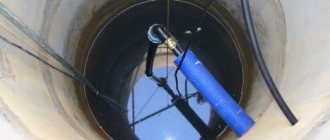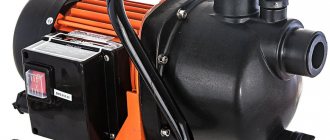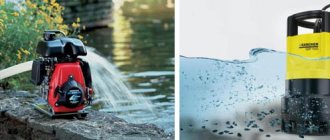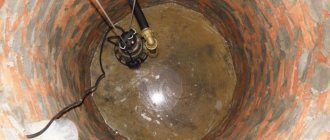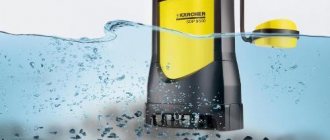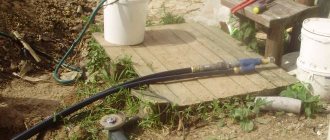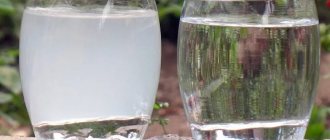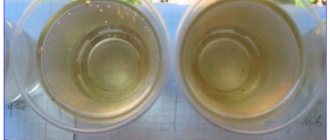When the construction of the well is completed, you can move on to the next, no less important stage. We choose a suitable pump for pumping dirty and clean water from a well: well pumps for a summer house, vegetable garden and garden, as well as other household needs. Water supply from a well in most cases involves extracting water using a pump; of course, pulling out 5-10 buckets a day is not a problem, but if water is also needed for washing, bathing or watering the garden, then the issue of purchasing pumping equipment comes to the fore.
Diagram: pump device for pumping water from a well
The problem is that the range of well workers on the market is so large that it can be very difficult for a non-technically savvy person to make a choice.
Technical characteristics that are taken into account when choosing a pump
When choosing pumping equipment, it is important to calculate in advance some parameters that the unit must meet and determine the operating conditions.
- Height of the water column. Distance from the bottom filter to the water mirror. This value allows us to determine the possibility of using submersible pumps, which must be completely submerged in water and located at a height of at least 1 meter from the bottom, otherwise it will not be possible to use such units and you will have to think about purchasing a surface device.
- Dynamic water level. Also called well flow rate. The indicator determines the rate of water flow into the mine when the pump is running. The pump performance should not be higher than the flow rate, otherwise water will be pumped out faster than it flows in.
Pump for pumping water from a well
- Pressure An indicator that determines whether the unit can lift water from the well and direct it to the drain point without losing pressure in the water supply system. To calculate the pressure, measure the length from the point of intake to the extreme point of discharge and add 10%.
- Performance. To calculate the pump's performance, it is necessary to sum up all water intake points in the house and on the site. On average, it is believed that each plumbing fixture consumes about 500 l/hour. By adding up their number, the required productivity is obtained. If water is used for irrigation, then SNiP standards are taken as a basis - 4-5 liters of water per hour are consumed per 1 square meter of garden.
- Well water quality. As you know, water in wells is not as clean as in a well, which is caused by the shallow occurrence of groundwater, so they often contain suspensions and impurities of solid particles of various fractions. Absolutely all models can be classified as pumps capable of pumping clean water. For pumping dirty water, units are selected that can work with mechanical contaminants larger than 5 millimeters in size. As a rule, they are distinguished by a reinforced design, increased diameter of the pipes and increased power, and are often equipped with a filter or cutting mechanism.
Pumps vary in the depth of possible immersion in water
- Terms of Use. Most pumps for wells in the country are used only in the warm season; these can be both submersible and surface models, but in some cases you need devices that can provide year-round water supply, then it is better to choose submersible deep units.
Application area
For country houses and dachas, drainage pumps are indispensable. Using such a device, you can pump out well water from an underground reservoir before cleaning it, organize the supply of water for irrigation from natural reservoirs or storage tanks, and also solve many other problems.
Before installing such a pump, it is necessary to make sure that the liquid for which it is planned to be used for pumping meets the requirements for the size of insoluble inclusions contained in its composition.
The need to use drainage pumps arises in the following situations:
- an increase in groundwater levels, which leads to excessive filling of wells and waste tanks, the appearance of water in the basements and cellars of houses;
- liquidation of the consequences of the past flood;
- liquidation of the consequences of a pipeline break;
- tidying up the local area after heavy rainfall;
- supplying water to fountains, maintaining artificial reservoirs and swimming pools;
- supplying water to drip irrigation systems for plants growing over large areas.
Which pump to choose for pumping water from a well
First, you need to decide on the type of pumping station. The following units can be used to pump water from a well:
- Superficial;
- Submersible;
- Motor pumps;
- Drainage
Types of pumps according to their method of operation
According to their design they can be divided into:
- Vibrating;
- Centrifugal;
- Suction.
According to the housing layout, pumps are:
- Horizontal (surface pumps and motor pumps);
- Vertical (submersible and drainage).
Submersible centrifugal pumps
Submersible well pumps with a centrifugal mechanism are made in the form of a sealed cylinder, usually made of stainless steel, sometimes made of plastic. The suction pipe is located at the bottom of the housing, and the motor is located at the top.
It is important that such a unit is completely immersed in water during operation, otherwise the engine will not cool, which will lead to overheating and failure. Various devices are used to regulate the water level, but the most reliable is a well pump with a conventional float.
Submersible centrifugal pumps for wells
Advantages:
- Pump immersion depth up to several tens of meters;
- Pressure up to 60 meters;
- Performance varies widely depending on the model, which makes it possible to choose exactly the one that suits your needs.
Flaws:
- Connecting the pump requires proper installation of power supply to the well;
- The cost of such units is an order of magnitude higher than surface units;
- In cases of improper operation, there is a possibility of pump failure, chamber depressurization and oil spill. An oil stain from the surface of the water is difficult to remove; a complete cleaning of the shaft is usually required.
Installation procedure
Installation of the drainage pump, the correct implementation of which determines the correctness of its operation, is carried out according to the following algorithm:
- The suction pipe is connected to a pressure hose or pipe.
- A float sensor is installed in the well, which will automatically turn on the pump when the water level rises and turn it off when all excess water has been pumped out.
- If the pump is connected to a three-phase power supply, it is necessary to check that the drive motor shaft rotates clockwise.
Installation diagram of a submersible drainage pump
Submersible vibration pumps
This type of device is more often used at the dacha “in season” for watering the garden and arranging water supply on the site. Advantages:
- Relatively low cost;
- Easy installation and operation;
- The pressure may vary depending on the model, the maximum is within 60 meters;
Submersible Vibration Pump
Disadvantages
- Low performance;
- Such units cannot be used for wells that are built on quicksand.
Advice! The most practical option for a well would be a pump that, in addition to supplying clean water, can also pump out dirty water, for example, when it is necessary to clean the mine or draw water from another source.
Selection tips, criteria
In outline
When purchasing a water pump, it is necessary to take into account its scope, service life, whether the product has a warranty, cost, quality, and manufacturer.
First, you need to decide what category of pump is required - household or industrial. Then, a device is selected that meets all the requirements and is most suitable for work in a particular area.
It is not advisable to purchase a device from dubious sellers, as there is a risk of running into scammers. Also, it is important to pay attention to user reviews of a particular pump: if the product gets mostly negative reviews, you should think about purchasing another one.
Criterias of choice
Price. This is the first thing that most people pay attention to when purchasing a particular product. First of all, you need to analyze the market: find the average price of the required pump and, starting from it, look for offers from sellers. You cannot choose a device based on too low a cost: such a pump will most likely not last long, or will not be of the same quality as the price.
Quality. In order to understand how convenient a particular product is to use, it is best to study reviews of real users about it - there are special sites for this, reviews are also left in online stores, etc.
Device power. This criterion determines how much water is pumped out in a certain unit of time (minute). The higher the power, the more energy the device consumes, but the faster the work process occurs. For household needs, a power of 1 kW is sufficient.
Service life, warranty - all this is clarified immediately before purchasing a specific pump from the seller. If the purchased device turns out to be defective or inoperative, it is returned back to the distributor and either the amount paid for it is refunded, or the product must be exchanged for a new one that works.
When it comes to drainage pumps, the permissible size of solid particles in the water is also taken into account. If this criterion does not meet the actual operating conditions, the pump will break down.
Scope of work. If the device is needed to carry out work in a country house, suburban area, etc., first of all you should pay attention to household pumps: they have a suitable price and perform the appropriate functions.
Outlet pipe diameter. Subsequently, it is also necessary to additionally purchase a hose of suitable size.
The maximum depth to which the pump can be immersed in water (if we are talking about submersible, drainage and other pumps). This parameter depends on the purpose for which the device is purchased.
Surface pumps for wells
The surface pump is installed on a flat area, on the surface; installation in a farm building is possible. Two hoses extend from the unit: one is connected to the suction pipe and the other end is lowered into the well. The second hose connects the pump to the drain point. The length of the hoses, as a rule, does not exceed 7 meters; this is not always enough if the pump is purchased for watering a garden or for a deep well. Advantages:
- On the one hand, such pumps are quite reliable and practical, but on the other hand, they are sensitive to moisture in the atmosphere (rain, fog), for the reason that the housing is not well sealed.
- High pressure and high performance.
- There is no need to lay a waterproofed electrical main to the well;
- Long-term uninterrupted operation;
- Ability to pump out both clean and dirty water. The number and sizes of permissible inclusions are indicated in the technical data sheet of the device
Surface pump for a well
Disadvantages:
- The suction height of such units usually does not exceed 9 meters, that is, they can be used for wells no more than 6-7 meters deep.
- Pump operation is accompanied by a high noise level;
- The suction line must be filled with water before starting.
Review of popular models
Models from Russian and foreign manufacturers are represented on the pumping equipment market. Every brand has its fans.
Budget pumps from Russian companies Vikhr and Malysh attract with their affordable prices and good performance. German pumps of the brands Wilo Drain, Grundfos, Karcher, like Japanese Makita, do not need advertising.
These devices have high performance and reliability throughout their entire service life. When purchasing pumping equipment, be sure to check the availability of all components specified in the attached instructions.
Pay attention to the restrictions on use specified by the manufacturer. Remember that the technical characteristics of different pump models may differ significantly, which also affects the way they are used.
Motor pumps
Motor pumps are centrifugal pumps that are additionally equipped with a diesel or gasoline engine, which makes them mobile and independent of power supply. This option is indispensable if there is no electricity at the dacha and the garden needs to be watered. Advantages:
- Mobility and compactness;
- Independence from electricity.
Motor pump
Disadvantages:
- Fuel costs;
- Even motor pumps with maximum power can lift water to a height of no more than 8 meters;
- Productivity, as a rule, does not exceed 2000 l/minute;
- Before starting the unit, it is necessary to fill the working volume with liquid.
- The noise level is higher than that of surface pumps;
- Exhausts and smell.
How to choose material of manufacture
Be sure to choose high-quality and durable materials. It is advisable to buy metal products or devices that use combinations of several materials. Products can be made of stainless steel or polymer materials.
The product body can be made of the following materials:
- Plastic models are easy to use and are cheap. The products require careful care, but they break quickly; it is better to buy more durable devices.
- Metal structures can be made of steel and cast iron. The equipment is made of high quality, rarely breaks, and is durable. The disadvantages of the designs are their large dimensions and non-transportability. When installing devices, some difficulties arise; this should be taken into account when choosing.
- Combined materials. If you choose a model from a good company, they will serve for a long time. Products made from wear-resistant polymer materials best withstand loads. They do not rust, do not wear out and can withstand heavy loads. Polymer compositions make devices more resistant and aggressive to mechanical stress.
When choosing devices, the following basic criteria should be taken into account: material of parts and housing, design features, volume of the working chamber, diameter of the outlet pipes, and so on. Choose pumps that have low noise levels. We hope our tips and recommendations will help you in the future.
Drainage pumps
Such units are often used for pumping dirty water from wells during their startup or cleaning. They are rarely used for clean drinking water, based on hygienic reasons; in addition, when passing through an inexpensive drainage pump, the water sometimes acquires an unpleasant odor. To pump water from a well, submersible drainage pumps are used; semi-submersible ones are inconvenient to install in a mine. Advantages:
Designed for long-term use;
- To water your garden, you can choose the simplest budget model;
- They are universal and can be used for other household needs, including pumping water from basements, cellars or mines while cleaning the source;
- They are characterized by high productivity.
Drainage pumps
Disadvantages:
- They do not provide strong water pressure (maximum lift height 20 m, average 10 m);
- High noise level.
Advice!
If it is necessary to lift water from a greater depth than that for which a surface pump or motor pump is designed, install an ejector. This equipment allows you to add several meters of lift and protects the pumping station from dry running. The ejector is lowered into the water along with the hose. During operation of the pump, part of the liquid flows back through an additional “trunk”, and the water pressure at the inlet increases.
Price
Below is the average price for well sump pumps of popular models.
| Model | Power, W | Capacity, l/min | Particle size, mm | Liquid lifting height, m | Price, rub |
| GILEKS DRAINER 110/6 | 200 | 110 | 5 | 6 | 2500 |
| GARDENA 6000 Classic | 220 | 100 | 25 | 5 | 3900 |
| Caliber NPTs-750/35P | 750 | 225 | 30 | 8 | 3200 |
| VORTEX DN-900 | 900 | 258 | 35 | 8 | 3400 |
| MAKITA PF0800 | 800 | 220 | 5 | 9 | 5400 |
